Approximately 200 000 Indigenous people live in British Columbia, with 198 distinct First Nations. Within this population, there are thirty different languages and close to sixty different dialects.
Archaeological evidence in the Great Bear Rainforest dates First Nations settlements at over 10 000 years old, representing an Indigenous presence in the region since the end of the most recent Ice Age.
Today, the population of coastal First Nations in B.C. is estimated at between 18 000 to 20 000. Their histories, identities, and spirituality are linked to the lands and waters of the rainforest.
Many First Nations have traditional territories in the Great Bear Rainforest region.
Each has distinct traditions, languages, and oral histories.
For information about Indigenous-led tourism opportunities within the Great Bear Rainforest and elsewhere within B.C., see the Indigenous Tourism BC website.
Communities in the Great Bear Rainforest region include two First Nations alliances (Coastal First Nations and Nanwakolas Council) as well as 15 non-aligned First Nations:
Coastal First Nations
- Gitga’at (Hartley Bay)
- Heiltsuk Nation (Bella Bella)
- Kitasoo / Xai’xais Band (Klemtu)
- Metlakatla First Nation
- Nuxalk Nation
- Wuikinuxw Nation
Nanwakolas Council
- Tlowitsis Nation
- Mamalilikulla Qwe Qwa Sot’em Band
- K’omoks First Nation (Comox)
- Wei Wai Kum (Campbell River)
- Da’naxda’wx Awaetlatla First Nation (Knight Inlet)
Non-aligned First Nations
- Dzawada’enuxw First Nation (Kingcome Inlet)
- Gitxaala Nation (Kitkatla)
- Gwa’sala Nakwaxda’xw Nation (Port Hardy)
- Gwawaenuk Tribe (Hopetown/Watson Island)
- Haisla Nation (Kitimat)
- Homalco Indian Band
- Kitselas Nation (Terrace)
- Kitsumkalum First Nation
- Kwiakah First Nations (Phillips Arm/Frederick Arm)
- Kwikwasut’inuxw Haxwa’mis First Nation (Gilford Island)
- Lax Kwa’alaams Indian Band
- ‘Namgis First Nation
- Nisga’a Lisims Government
- Ulkatcho First Nations
- We Wai Kai First Nation (Cape Mudge)
For more information, see the Province of B.C.’s Great Bear Rainforest Partners and Communities webpage.
Historical wrongs
In 1876, the Government of Canada enacted the Indian Act to assimilate First Nations into Euro-Canadian society. The fact that First Nations peoples and cultures continue to flourish in their traditional territories and beyond is testament to their resiliency.
The Indian Act’s implementation caused devastating impacts on First Nations peoples across the country. Additional laws were passed in subsequent years to further limit First Nations’ activities, including the following:
- From 1884 to 1951, it was a criminal offense for First Nations to practice their traditional culture in the form of feasts or potlatches.
- In 1889, the Federal Fisheries Act was passed. This law banned First Nations from selling fish or owning fishing licenses.
- In 1920, the government made attendance at school compulsory for Indigenous children. This marked the beginning of residential schools in Canada. The government considered the schools necessary because the process of assimilation was not succeeding as quickly as the government hoped. The last residential school closed in 1996.
- Between 1927 and 1951, a law was passed that made raising money for First Nations land claims in Canada an offense punishable by law.
- The right for First Nations to vote was withdrawn in 1872. Indians were not permitted to vote in provincial elections until 1947, and federal elections until 1960.
- In the 1940s and 1950s, a Commission was created in South Africa to study Canada’s reservations systems. The research was used to create “reservations” in South Africa as part of the Apartheid regime in that country.
These laws profoundly changed life for First Nations living within what is now known as the Great Bear Rainforest region, as well as elsewhere in Canada. For more information about the impact of Canadian Government policies on First Nations, see the following resources:
- Indian Residential Schools and Reconciliation: Teacher Guide 10 (First Nations Education Steering Committee and First Nations Schools Association)
- Residential Schools in Canada: Education Guide (Heritage Minutes)
- B.C. First Nations Studies textbook (B.C. Ministry of Education)
Church apologies
The United Church of Canada issued an apology to Indigenous peoples in 1986. 15 residential schools were run by the church between 1849 and 1969. The church apologized again in 1998 and has worked with the Truth and Reconciliation Commission of Canada since 2008 to address historical wrongs and the legacy of the residential school system.
In 1993, the Anglican Church of Canada apologized for its role in the residential school system.
The Presbyterian Church in Canada apologized for its role in the residential school system in 1994.
In 2017, Justin Trudeau, the Prime Minister of Canada, formally requested that Pope Francis apologize for the role of the Catholic Church in the residential school system. Trudeau received a letter from a Catholic Church representative nearly one year later, stating that the pope would not apologize.
Government of Canada apology
In 2008, then-Prime Minister of Canada Stephen Harper offered a full apology for the role of the Canadian government in residential schooling.
Reconciliation
First Nations within the Great Bear Rainforest region are in varying stages of negotiation with the Province of British Columbia regarding land and resource use. These reconciliation initiatives are occurring as part of the treaty process, and also address asserted territories outside of the B.C. treaty process.
For more information on specific First Nations, refer to the Province of British Columbia’s First Nations A-Z listings.


